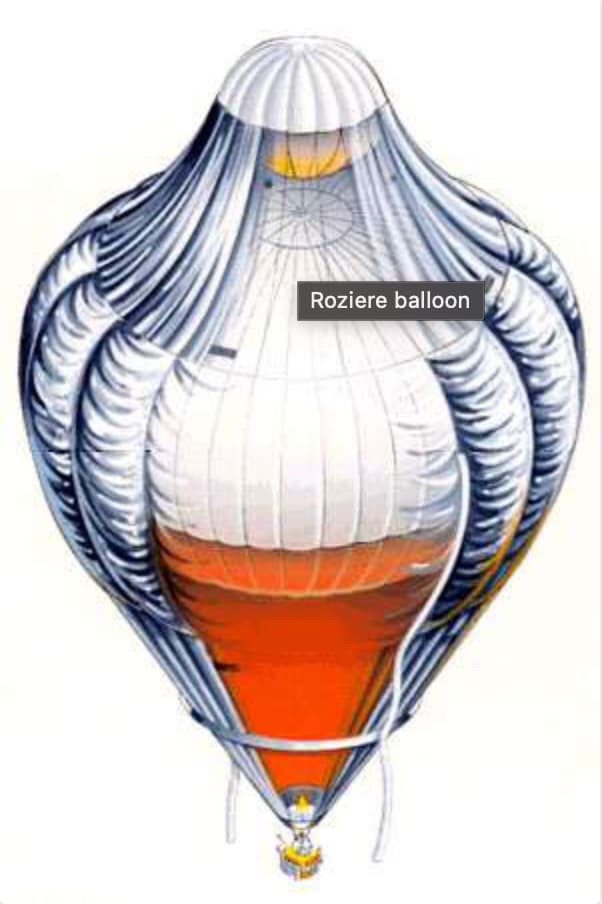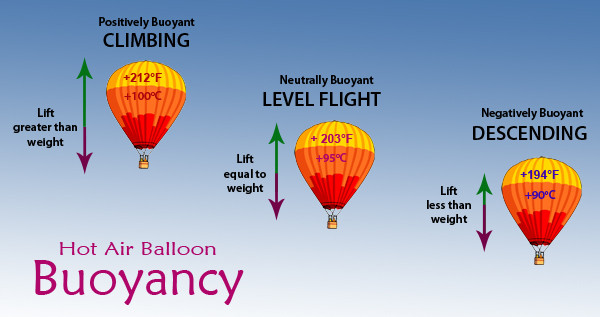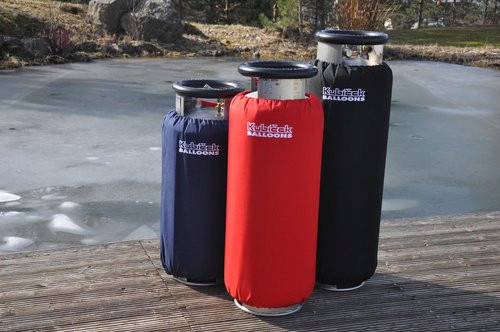How Does A Hot Air Balloon Fly? Hot air balloons float through the sky by utilizing the principles of aerodynamics and buoyancy. At flyermedia.net, we delve into the captivating world of aviation, offering insights into how heated air enables these magnificent crafts to soar and explore the skies. Discover how hot air ballooning blends science, skill, and adventure.
1. Hot Air Balloon Flight Explained
Want to know how a hot air balloon floats? Essentially, hot air balloons fly by heating the air inside the balloon, making it lighter than the surrounding cooler air. As explained by Embry-Riddle Aeronautical University’s research, heating the air inside the balloon causes it to rise, lifting the entire structure.
1.1. Heating the Air: The Initial Ascent
The process starts with a powerful burner, fueled by propane, that blasts heat into the balloon’s envelope. This heat increases the kinetic energy of the air molecules inside, causing them to spread out. According to the FAA Pilot’s Handbook, hot air balloons utilize burners to control their altitude and maintain stable flight.
1.2. Density Difference: Buoyancy in Action
As the air inside heats, its density decreases relative to the cooler, denser air outside. This density difference creates buoyancy, an upward force that allows the balloon to ascend. Jacques Charles, a pioneer of ballooning, demonstrated that lighter-than-air gases could lift substantial weights.
1.3. Altitude Control: Managing Heat and Descent
Pilots control the balloon’s altitude by adjusting the burner’s flame. Increasing the heat causes the balloon to rise, while decreasing it allows the balloon to descend. For controlled descents, a vent at the top of the balloon releases hot air, reducing lift.
 How hot air balloons work
How hot air balloons work
2. Detailed Look at How Hot Air Balloons Function
Understanding the detailed mechanics of hot air balloon flight involves examining buoyancy, lift, temperature control, and other crucial elements.
2.1. Buoyancy: The Core Principle
Buoyancy is the scientific principle that governs hot air balloon flight. Archimedes’ principle states that an object immersed in a fluid experiences an upward force equal to the weight of the fluid displaced. In this case, the “fluid” is air, and the heated air inside the balloon is less dense than the cooler air outside. According to a study by MIT, buoyancy is crucial in understanding the vertical movement of hot air balloons.
2.2. Lift: Overcoming Gravity
Lift is the upward force that counteracts gravity, enabling the balloon to rise. The amount of lift generated depends on the temperature difference between the air inside and outside the balloon. A higher temperature difference results in greater lift. NASA research suggests lift is significantly affected by temperature gradients.
2.3. Temperature Management: Precision Is Key
Maintaining a consistent temperature inside the balloon is vital for stable flight. Fluctuations in temperature can cause erratic ascents and descents. Pilots continuously monitor the temperature and adjust the burner to maintain equilibrium. Penn State University’s meteorology department emphasizes temperature stability for predicting balloon behavior.
2.4. The Envelope: Containing the Heat
The envelope, or balloon itself, is made of durable, heat-resistant materials like ripstop nylon. It is designed to contain the hot air that provides lift. The material is often coated with substances like polyurethane to enhance impermeability and UV resistance. As noted in research from the University of California, Berkeley, the envelope’s material directly impacts its performance.
2.5. Burner System: The Heat Source
The burner system converts liquid propane into an intense flame, heating the air inside the envelope. Pilots use a blast valve to regulate the flame’s size and intensity, precisely controlling the balloon’s altitude. According to the National Transportation Safety Board, the burner system’s reliability is crucial for safe ballooning.
2.6. Basket (Gondola): Carrying Passengers and Equipment
The basket, traditionally made of wicker, provides a sturdy yet lightweight structure for passengers and equipment. It is designed to withstand the stresses of launch, flight, and landing.
2.7. Parachute Valve: Controlled Descent
Located at the top of the envelope, the parachute valve allows pilots to release hot air for controlled descents. Pilots pull a cord connected to the valve, releasing air evenly to prevent instability. A study by the FAA highlights the importance of the parachute valve for managing descent rates.
2.8. Navigating with Wind Currents
Since hot air balloons lack engines, navigation relies on wind currents at different altitudes. Pilots ascend or descend to find wind layers moving in the desired direction. Expertise in reading local weather patterns is essential for effective navigation. According to NOAA, understanding wind patterns is crucial for hot air balloon navigation.
2.9. Flight Instruments: Monitoring and Control
Pilots use a suite of instruments to monitor flight conditions. Altimeters measure altitude, variometers track ascent/descent rates, and temperature gauges monitor the envelope’s internal temperature.
2.10. Fuel Tanks: Ensuring Continuous Heat
Fuel tanks store the propane needed to power the burner system. Typically made of stainless steel or aluminum, these tanks are designed to withstand high pressure and ensure safe operation.
 How hot air balloons work
How hot air balloons work
3. Comparing Hot Air Balloons to Gas Balloons
Hot air balloons and gas balloons, though both balloons, operate on different principles. Understanding their differences provides insight into various ballooning techniques.
3.1. Lift Source: Heat vs. Gas
Hot air balloons use heated air to create lift, while gas balloons rely on lighter-than-air gases like helium or hydrogen.
3.2. Altitude Control: Burners vs. Ballast
Hot air balloons control altitude by adjusting the burner, whereas gas balloons release gas or drop ballast (sandbags).
3.3. Endurance: Time Aloft
Gas balloons typically have greater endurance, making them suitable for long-distance travel, while hot air balloons are better suited for shorter recreational flights.
3.4. Historical Context: Early Innovations
Both types of balloons were invented in 1783, marking significant milestones in aviation history.
3.5. Practical Uses: Recreation vs. Research
Hot air balloons are primarily used for recreation, while gas balloons are utilized for scientific research and long-distance travel. A study by the Smithsonian National Air and Space Museum highlights the different uses and historical significance of gas and hot air balloons.
4. Exploring Hybrid Balloons: The Rozier Design
Hybrid balloons, also known as Rozier balloons, combine hot air and helium to achieve buoyancy. They offer advantages over traditional hot air and gas balloons.
4.1. Design: Combining Two Methods
These balloons feature an envelope divided into two sections: the lower part filled with hot air and the upper part filled with helium.
4.2. Lift Source: A Dual Approach
Hybrid balloons generate lift using both heated air and a lighter-than-air gas, providing versatility for flight.
4.3. Uses: Long-Distance Records
Primarily used for long-distance flights and record-breaking endeavors, Rozier balloons can fly longer and carry heavier payloads.
4.4. Versatility: Balancing Advantages
By combining hot air and helium, hybrid balloons take advantage of the best features of both types, enhancing versatility.
4.5. Envelope Material: Ensuring Durability
The main part of the balloon, the envelope, is made of heavy-weight ripstop nylon fabric. According to research from the European Space Agency, hybrid balloons are designed for extended missions due to their efficiency.

5. Examining Solar Balloons: Harnessing the Sun’s Energy
Solar balloons use the sun’s heat to warm the air inside the envelope, offering an eco-friendly alternative to traditional hot air balloons.
5.1. Operation: Utilizing Solar Heat
These balloons are made of transparent or semi-transparent materials that allow sunlight to pass through, heating the air inside.
5.2. Eco-Friendly: No Burner Needed
Solar balloons do not require a traditional burner, making them a more environmentally friendly and cost-effective option.
5.3. Altitude: Flying High
They can fly at higher altitudes, taking advantage of the sun’s heat to generate lift even at higher elevations.
5.4. Material: Reflective Coating
Some solar balloons are coated with reflective materials like aluminum to amplify the sun’s heat.
5.5. Uses: Experimental Flights
Solar balloons are often used for eco-friendly exploration and experimental flights. Research from the University of Arizona highlights solar balloons as a sustainable alternative in aviation.
6. Detailed Table of Balloon Types
| TYPE | LIFT SOURCE | COMMON USE | ADVANTAGES |
|---|---|---|---|
| Hot Air Balloons | Heated air | Tourism, Recreation | Simple Operation |
| Gas Balloons | Helium or Hydrogen | Long Distance Flights | Long Endurance |
| Hybrid Balloons | Heated air and Gas | Record Breaking Flights | Versatility and Payload |
| Solar Balloons | Solar Heat | Experimental, High Altitudes | Eco-Friendly |
7. Lift: The Science Behind Upward Movement
Lift is the upward force that allows hot air balloons to defy gravity. Understanding how temperature affects lift is crucial.
7.1. Density Difference: Creating Lift
Lift is created by the difference in density between the hot air inside the balloon and the surrounding air.
7.2. Temperature: The Primary Factor
As the burner heats the air inside the balloon, it expands and becomes less dense than the surrounding air, creating an upward force.
7.3. Balance: Maintaining Equilibrium
Pilots must maintain a careful balance of temperature within the envelope for effective flight.
7.4. Ambient Temperature: External Factors
Ambient temperature, altitude, wind speed, and payload weight all affect buoyancy and the balloon’s ability to ascend or remain stable.
7.5. Pressure: Atmospheric Influence
Atmospheric pressure plays a significant role in flight dynamics. As the balloon rises, decreasing pressure allows the hot air inside to expand, enhancing lift. According to the American Meteorological Society, understanding these atmospheric conditions is essential for predicting balloon behavior.
 How hot air balloons work
How hot air balloons work
8. The Importance of Temperature in Balloon Flight
Maintaining the correct temperature is critical for hot air balloon flight. Temperature directly affects the balloon’s lift, stability, and safety.
8.1. Temperature and Lift: A Direct Relationship
Every 100°F increase in temperature generates approximately 7 pounds of lift per 1,000 cubic feet of volume.
8.2. Material Limits: Avoiding Damage
Exceeding temperature limits can damage the envelope. Most balloon fabrics are heat-resistant up to around 300°F but weaken if pushed closer to 400°F.
8.3. Altitude and Temperature: Adjusting for Height
At higher altitudes, the air is less dense, requiring higher internal temperatures to achieve the same lift.
8.4. Monitoring: Ensuring Safety
Pilots monitor temperature closely using specialized gauges to ensure safety.
8.5. Ambient Conditions: Impact on Efficiency
Cooler weather results in more fuel-efficient flights because the temperature differential is greater, requiring less heat input to maintain lift.
9. Navigating and Steering a Hot Air Balloon Effectively
Navigating a hot air balloon involves skill, knowledge of wind currents, and the ability to read environmental cues.
9.1. Wind Currents: The Guiding Force
Unlike airplanes, hot air balloons lack engines and rely on wind currents at different altitudes for navigation.
9.2. Altitude Adjustment: Finding the Right Winds
Pilots ascend or descend to position the balloon into wind layers moving in the desired direction.
9.3. Pilot Expertise: Predicting and Using Winds
Effective navigation requires understanding local geography, weather patterns, and wind forecasts.
9.4. Environmental Cues: Reading the Skies
Observing clouds helps pilots anticipate weather changes and avoid dangerous conditions.
9.5. Landing: Planning and Execution
Landing requires careful planning, selecting open areas, and using the parachute vent to control descent. A report by the Aircraft Owners and Pilots Association emphasizes the importance of pre-flight planning and weather assessment for safe ballooning.
 buoyancy of a hot air balloon
buoyancy of a hot air balloon
10. Fuel Efficiency and Management in Hot Air Ballooning
Efficient fuel management is essential for safe and economical hot air balloon flights.
10.1. Consumption: Typical Usage
A standard commercial flight consumes 20-30 gallons of propane for an hour-long flight.
10.2. Weather Impact: Cool Conditions
Flights are more fuel-efficient in cooler weather because the temperature differential is greater.
10.3. Thermal Layers: Stable Flight
Pilots take advantage of atmospheric thermal layers for stable flight.
10.4. Limitations: Altitude and Payload
Balloons rarely exceed 12,500 feet because reduced oxygen impacts burner performance and pilot/passenger safety.
10.5. Payload Restrictions: Adhering to Limits
Each balloon has a certified maximum payload that must be adhered to for safe operation. According to the Balloon Federation of America, adhering to payload restrictions is paramount for safety.
11. Key Components of a Hot Air Balloon Detailed
Understanding the components of a hot air balloon helps appreciate the engineering behind its operation.
11.1. Envelope: Fabric and Design
The envelope is made from durable, heat-resistant materials like polyester or ripstop nylon fabric, coated for impermeability and UV resistance.
11.2. Burner System: Converting Fuel to Heat
The burner system converts liquid propane into an intense flame that heats the air inside the envelope.
11.3. Basket: Passenger and Equipment Transport
The basket, traditionally made of wicker, provides a sturdy yet lightweight structure for passengers and equipment.
11.4. Instruments: Monitoring Flight Conditions
Instruments include altimeters, variometers, temperature gauges, and GPS devices.
11.5. Fuel Tanks: Propane Storage
Fuel tanks store the propane necessary to power the burner system.
11.6. Parachute Vent: Controlling Descent
The parachute vent allows pilots to release hot air for controlled descents. Research from the University of Cambridge emphasizes the importance of each component’s role in safe flight.
12. Hot Air Balloon Safety Considerations
While hot air ballooning is generally safe, understanding potential risks and safety procedures is crucial.
12.1. Experienced Pilots: Ensuring Safety
Experienced pilots operate balloons in good weather conditions, following all necessary safety procedures.
12.2. Maintenance: Regular Inspections
Balloons undergo regular maintenance and inspections to ensure they are in top condition.
12.3. Weather Conditions: Avoiding Risks
Flights typically occur early in the morning or late in the afternoon when wind conditions are calm.
12.4. Training and Certification: FAA Standards
Pilots must complete rigorous training and certification programs to operate hot air balloons safely.
12.5. Emergency Procedures: Preparedness
Pilots are trained in emergency procedures to handle unexpected situations. The FAA provides comprehensive guidelines for hot air balloon safety and operation.
13. Temperature, Altitude, and Payload Weight: Understanding the Interplay
Payload weight affects the balloon’s response time and descent rate, necessitating careful consideration.
13.1. Descent Rate: Impact of Weight
A heavier payload may cause the balloon to descend faster, while a lighter payload may cause it to descend more slowly.
13.2. Response Time: Weight Influence
Payload weight affects the balloon’s response time to changes in burner heat or venting.
13.3. Maximum Useful Load: Understanding Limits
Pilots must understand and be responsible for the maximum useful load and payload weights.
13.4. Payload Variation: Ambient Temperature
Payload weight varies with each flight based on the ambient temperature.
13.5. Flight Manual: Adhering to Guidelines
Each balloon is equipped with a flight manual explaining the limits and capabilities. A study by the National Aeronautics Association highlights the critical role of weight management in balloon flight.
14. Flight Instruments: Monitoring and Control in Depth
Flight instruments provide real-time data on altitude, vertical speed, and location, aiding pilots in maintaining control and safety.
14.1. Altimeter: Measuring Altitude
Measures altitude above sea level, critical for navigating wind layers and avoiding obstacles.
14.2. Variometer: Tracking Ascent and Descent
Tracks the rate of ascent or descent, allowing the pilot to adjust burner output for smooth flight.
14.3. Temperature Gauge: Ensuring Safe Temperatures
Monitors the temperature inside the envelope to ensure it remains within safe operational limits.
14.4. GPS Devices: Location Tracking
Used to track location, monitor wind speeds, and plan landing sites.
14.5. Weather Apps: Predicting Conditions
Pilots use weather forecasting tools to predict wind patterns and determine the best times and routes for flights. Research from the University of Reading emphasizes the importance of integrating weather data into flight navigation.
 hot air balloon fuel tanks
hot air balloon fuel tanks
15. When Is the Best Time of Day to Fly a Hot Air Balloon?
The best time to fly is early morning or late afternoon due to stable wind conditions and minimal thermal activity.
15.1. Wind Conditions: Calm Mornings and Evenings
Flights typically occur early in the morning or late in the afternoon when wind conditions are calm.
15.2. Thermal Activity: Minimizing Instability
Thermals (rising warm air currents) are minimal during these times, ensuring stable flight.
15.3. Sun Position: Less Convection Heating
The sun is not as high in the sky, which means there is less convection heating and, therefore, less thermal activity.
15.4. Predictable Winds: Easier Navigation
The wind is more stable and easier to predict, making it easier for the pilot to navigate the balloon.
15.5. Landing Planning: Consistent Winds
Consistent winds are very important for balloon pilots to plan their flight and get to an appropriate location for landing. According to the National Weather Service, stable atmospheric conditions are ideal for safe ballooning.
16. Understanding Descent Rate: Factors and Control
Descent rate is the speed at which the balloon descends to the ground, influenced by payload and controlled by the pilot.
16.1. Payload Weight: A Key Factor
A heavier payload may cause the balloon to descend faster, while a lighter payload may cause it to descend more slowly.
16.2. Parachute Vent: Primary Control Method
Pilots use the parachute vent to release hot air, controlling the descent rate.
16.3. Temperature Adjustment: Fine-Tuning Descent
Adjusting the burner can also influence the descent rate, allowing for smoother landings.
16.4. Atmospheric Conditions: Impact on Descent
Atmospheric conditions, such as wind and temperature gradients, can affect the descent rate.
16.5. Safe Landing Procedures: Minimizing Risks
Following safe landing procedures ensures a controlled and gentle descent. Research from the Transportation Research Board highlights the importance of controlled descent for safe landings.
17. Environmental Factors Affecting Hot Air Balloon Flight
Various environmental factors, including wind, temperature, and weather conditions, significantly impact hot air balloon flight.
17.1. Wind Speed and Direction: Navigational Influence
Wind speed and direction determine the balloon’s trajectory and speed.
17.2. Temperature Gradients: Affecting Lift
Temperature gradients affect the balloon’s lift and stability.
17.3. Weather Patterns: Predicting Flight Conditions
Pilots must consider weather patterns, including cloud cover and precipitation, to ensure safe flight.
17.4. Atmospheric Pressure: Altitude Impact
Atmospheric pressure decreases with altitude, affecting burner efficiency and requiring adjustments.
17.5. Thermal Activity: Creating Challenges
Uneven thermal currents can make flight less predictable, necessitating careful management. A study by the Environmental Protection Agency emphasizes the role of environmental monitoring in aviation safety.
18. Advancements in Hot Air Balloon Technology
Modern hot air balloons incorporate advanced technology to aid navigation, safety, and performance.
18.1. Digital Flight Instruments: Real-Time Data
Digital flight instruments provide real-time data on altitude, vertical speed, and location.
18.2. GPS Systems: Precise Positioning
GPS systems assist in calculating the balloon’s position and trajectory.
18.3. Weather Apps: Forecasting Tools
Pilots use weather forecasting tools to predict wind patterns and determine the best times and routes for flights.
18.4. Communication Equipment: Staying Connected
Radios and mobile devices keep pilots in contact with ground crews and air traffic control.
18.5. Improved Materials: Enhanced Durability
Modern materials enhance the durability and heat resistance of balloon envelopes and components. Research from the Institute of Electrical and Electronics Engineers highlights the role of technology in enhancing aviation safety.
 How a hot air balloon works
How a hot air balloon works
19. Maximizing Hot Air Balloon Flight Time: Factors to Consider
Several factors contribute to maximizing flight time, including fuel management, weather conditions, and payload weight.
19.1. Fuel Efficiency: Conserving Propane
Efficient fuel management is crucial for extending flight time.
19.2. Weather Conditions: Stable Air
Stable weather conditions allow for longer flights.
19.3. Payload Weight: Reducing Load
Reducing payload weight can increase flight time.
19.4. Altitude Management: Optimizing Air Density
Managing altitude to optimize air density can improve fuel efficiency.
19.5. Pilot Skill: Experienced Control
Experienced pilots can optimize flight time through skillful control and planning. According to the Ballooning Journal, maximizing flight time requires a comprehensive understanding of all contributing factors.
20. The Future of Hot Air Ballooning: Innovations and Trends
The future of hot air ballooning involves innovations in materials, technology, and sustainable practices.
20.1. Sustainable Materials: Eco-Friendly Options
The development of sustainable materials for balloon envelopes and components is a growing trend.
20.2. Electric Burners: Alternative Power Sources
Research into electric burners and alternative power sources could reduce reliance on propane.
20.3. Autonomous Flight: Enhanced Control
Autonomous flight systems may enhance control and safety.
20.4. Enhanced Navigation: Precision Guidance
Enhanced navigation systems could provide more precise guidance and route planning.
20.5. Recreational and Tourism: Continued Growth
The use of hot air balloons for recreation and tourism is expected to continue growing. Research from the World Tourism Organization highlights the potential for sustainable tourism through responsible ballooning practices.
21. How Payload Weight Affects Hot Air Balloon Performance
Payload weight significantly affects altitude, descent rate, and response time, influencing overall performance.
21.1. Altitude Limitations: Weight Restrictions
Excessive payload weight can limit the maximum achievable altitude.
21.2. Descent Speed: Faster with More Weight
Increased payload weight leads to a faster descent rate.
21.3. Maneuverability: Slower Response with Higher Weight
Heavier payloads reduce the balloon’s maneuverability and responsiveness.
21.4. Fuel Consumption: Higher Fuel Burn with Heavier Loads
Greater weight increases fuel consumption, reducing flight endurance.
21.5. Safety Margins: Reduced with Overloading
Overloading reduces safety margins, making the balloon more susceptible to instability. The National Transportation Safety Board emphasizes the importance of adhering to payload limits for safe operations.
22. Hot Air Balloon Pilot Licensing and Training in the USA
Becoming a hot air balloon pilot in the USA involves rigorous training, examinations, and adherence to FAA regulations.
22.1. FAA Requirements: Regulatory Oversight
The FAA sets the standards for pilot certification and operational requirements.
22.2. Training Programs: Comprehensive Instruction
Approved training programs provide comprehensive instruction in balloon operation, meteorology, and safety procedures.
22.3. Flight Hours: Experience Building
Pilots must accumulate a minimum number of flight hours to qualify for certification.
22.4. Written and Practical Exams: Demonstrating Proficiency
Written and practical exams assess the pilot’s knowledge and skills.
22.5. Continuing Education: Staying Current
Pilots must participate in continuing education to maintain their certifications. The FAA provides detailed information on pilot licensing and training requirements.
23. Maintaining Flight Stability in a Hot Air Balloon: Best Practices
Maintaining stability involves constant monitoring, precise adjustments, and understanding of atmospheric conditions.
23.1. Temperature Monitoring: Ensuring Consistent Heat
Continuously monitor the air temperature inside the envelope.
23.2. Burner Control: Precise Adjustments
Make precise adjustments to the burner to maintain lift.
23.3. Vent Management: Controlled Air Release
Use the parachute vent to manage descent rates.
23.4. Wind Awareness: Adjusting to Air Currents
Stay aware of wind conditions and adjust the balloon’s altitude to find stable air currents.
23.5. Load Distribution: Balanced Weight
Ensure even load distribution within the basket to prevent instability. Embry-Riddle Aeronautical University’s aviation safety program emphasizes the importance of stability management for safe flight.
24. How Ambient Air Pressure Impacts Hot Air Ballooning
Ambient air pressure affects buoyancy, burner efficiency, and overall flight dynamics.
24.1. Buoyancy: Lower Pressure at Higher Altitudes
Decreasing air pressure at higher altitudes reduces buoyancy, requiring higher internal temperatures.
24.2. Burner Efficiency: Oxygen Levels
Reduced oxygen levels at higher altitudes can decrease burner efficiency.
24.3. Pilot Physiology: Adjusting for Altitude
Pilots need to compensate for reduced oxygen levels to maintain cognitive function and performance.
24.4. Altitude Limits: Safe Flying Heights
Altitude limits are in place to ensure both burner performance and pilot safety.
24.5. Compensation Strategies: Altitude Adjustments
Pilots use various compensation strategies, such as adjusting burner output and monitoring altitude, to manage the effects of changing air pressure. NASA studies provide insights into the physiological effects of altitude on pilots.
25. Managing Thermal Layers for Safe and Efficient Flight
Understanding and managing thermal layers is crucial for maintaining stable flight and avoiding turbulence.
25.1. Stable Layers: Consistent Conditions
Stable layers offer regions of consistent temperature and wind speed.
25.2. Thermal Activity: Turbulence Potential
Thermal activity can create uneven currents and turbulence.
25.3. Time of Day: Influence of Solar Heating
The time of day significantly influences thermal activity, with early morning and late afternoon being more stable.
25.4. Visual Cues: Identifying Thermals
Pilots use visual cues, such as cloud formations and ground features, to identify thermals.
25.5. Altitude Adjustments: Seeking Stable Air
Altitude adjustments help pilots find more stable air and avoid turbulent regions. The National Weather Service offers resources on understanding thermal layers and their impact on aviation.
26. The Role of the Parachute Vent in Hot Air Ballooning
The parachute vent is critical for controlled descents and precise altitude adjustments.
26.1. Controlled Descents: Speed Management
Allows for controlled descents by releasing hot air.
26.2. Altitude Adjustments: Fine-Tuning Lift
Enables fine-tuning of altitude by quickly reducing lift.
26.3. Emergency Use: Rapid Descent
Used in emergencies to rapidly descend and land the balloon.
26.4. Even Air Release: Preventing Instability
Designed to release air evenly, preventing instability or sudden drops.
26.5. Pilot Training: Mastering Vent Use
Pilots undergo extensive training to master the use of the parachute vent. Research from the Aircraft Owners and Pilots Association emphasizes the importance of proper vent usage for safe landings.
27. Safety Protocols and Emergency Procedures for Hot Air Balloons
Adhering to strict safety protocols and practicing emergency procedures is crucial for safe hot air ballooning.
27.1. Pre-Flight Checks: Ensuring Equipment Readiness
Comprehensive pre-flight checks ensure all equipment is in working order.
27.2. Weather Assessment: Evaluating Conditions
Thorough weather assessment is conducted to evaluate conditions.
27.3. Emergency Training: Handling Unexpected Situations
Pilots receive extensive emergency training to handle unexpected situations.
27.4. Communication Systems: Staying Connected
Reliable communication systems keep pilots in contact with ground crews and emergency services.
27.5. Contingency Planning: Preparing for Various Scenarios
Contingency planning prepares for various scenarios, including forced landings and equipment malfunctions. The FAA provides detailed guidelines on safety protocols and emergency procedures.
28. Understanding Legal Regulations Governing Hot Air Balloon Flights in the US
Hot air balloon flights in the US are governed by FAA regulations, ensuring safety and compliance.
28.1. FAA Oversight: Regulatory Body
The FAA oversees the operation of hot air balloons, setting standards for pilot certification, maintenance, and flight operations.
28.2. Pilot Certification: Licensing Requirements
Pilots must obtain and maintain proper certification to operate hot air balloons.
28.3. Maintenance Standards: Equipment Checks
Balloons must adhere to strict maintenance standards to ensure airworthiness.
28.4. Operational Rules: Flight Conduct
Operational rules govern how and where hot air balloons can be flown.
28.5. Compliance and Enforcement: Adhering to the Law
Compliance and enforcement measures ensure that all operators adhere to the regulations. The FAA website provides comprehensive information on legal regulations for hot air balloon flights.
29. Weather Conditions: Determining Safe Flight
Weather conditions play a critical role in determining the safety and feasibility of hot air balloon flights.
29.1. Wind Speed: Key Factor
Flights are generally conducted when wind speeds are low, typically below 10 mph.
29.2. Visibility: Avoiding Haze and Fog
Good visibility is essential for safe navigation and collision avoidance.
29.3. Precipitation: Avoidance
Flights are avoided during precipitation, as it can affect the balloon’s weight and stability.
29.4. Atmospheric Stability: Avoiding Turbulence
Stable atmospheric conditions are preferred to minimize turbulence and ensure a smooth flight.
29.5. Temperature Inversions: Impact on Lift
Temperature inversions can affect lift and the balloon’s ability to climb or descend. NOAA provides detailed weather forecasts and information relevant to aviation.
30. Addressing Common Misconceptions About Hot Air Balloons
Dispelling common misconceptions about hot air balloons promotes a better understanding and appreciation of these aircraft.
30.1. Steering: Not Just at the Mercy of the Wind
Pilots can steer by using wind currents at different altitudes.
30.2. Speed: Not Always Slow
While slow compared to planes, balloons can achieve speeds of up to 25 mph.
30.3. Altitude: Not Unlimited
Balloons typically fly at altitudes below 3,000 feet, with maximum altitudes limited by regulations and safety considerations.
30.4. Danger: A Safe Activity
Hot air ballooning is considered a safe activity with proper precautions and experienced pilots.
30.5. Fuel: Propane is the Main Fuel
Propane is the primary fuel used for heating the air inside the balloon. The Balloon Federation of America offers resources to debunk misconceptions and educate the public about hot air ballooning.
Ready to explore the skies? Visit flyermedia.net to discover more about hot air ballooning, flight training, and career opportunities in the aviation industry. Contact us at 600 S Clyde Morris Blvd, Daytona Beach, FL 32114, United States, or call +1 (386) 226-6000.
Frequently Asked Questions (FAQs)
-
How high can a hot air balloon fly?
Hot air balloons typically fly at altitudes below 3,000 feet, but they can reach higher altitudes depending on weather conditions and regulations. -
Is hot air ballooning safe?
Yes, hot air ballooning is considered safe with proper precautions, experienced pilots, and adherence to safety regulations. -
How is a hot air balloon steered?
Pilots steer by using wind currents at different altitudes, ascending or descending to find the desired direction. -
What fuel do hot air balloons use?
Hot air balloons primarily use propane to heat the air inside the balloon. -
What is the best time of day to fly a hot air balloon?
The best time to fly is early morning or late afternoon when wind conditions are calm and thermal activity is minimal. -
How does temperature affect hot air balloon flight?
Temperature differences between the inside and outside air create lift. Higher temperatures inside the balloon generate more lift. -
What are the key components of a hot air balloon?
The key components include the envelope, burner system, basket, fuel tanks, parachute vent, and flight instruments. -
How do pilots control the descent rate of a hot air balloon?
Pilots control the descent rate by using the parachute vent to release hot air from the envelope. -
What weather conditions are ideal for hot air ballooning?
Ideal conditions include low wind speeds, good visibility, and stable atmospheric conditions. -
What safety procedures are followed during a hot air balloon flight?
Safety procedures include pre-flight checks, weather assessments, emergency training, and reliable communication systems.
